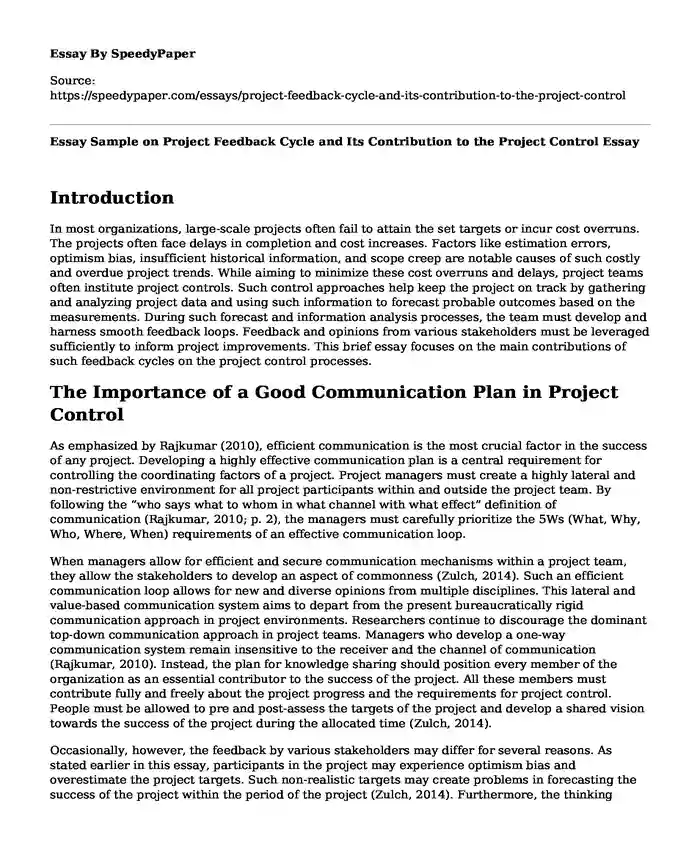
| Type of paper: | Essay |
| Categories: | Project management Company Management Communication |
| Pages: | 3 |
| Wordcount: | 623 words |
Introduction
In most organizations, large-scale projects often fail to attain the set targets or incur cost overruns. The projects often face delays in completion and cost increases. Factors like estimation errors, optimism bias, insufficient historical information, and scope creep are notable causes of such costly and overdue project trends. While aiming to minimize these cost overruns and delays, project teams often institute project controls. Such control approaches help keep the project on track by gathering and analyzing project data and using such information to forecast probable outcomes based on the measurements. During such forecast and information analysis processes, the team must develop and harness smooth feedback loops. Feedback and opinions from various stakeholders must be leveraged sufficiently to inform project improvements. This brief essay focuses on the main contributions of such feedback cycles on the project control processes.
The Importance of a Good Communication Plan in Project Control
As emphasized by Rajkumar (2010), efficient communication is the most crucial factor in the success of any project. Developing a highly effective communication plan is a central requirement for controlling the coordinating factors of a project. Project managers must create a highly lateral and non-restrictive environment for all project participants within and outside the project team. By following the “who says what to whom in what channel with what effect” definition of communication (Rajkumar, 2010; p. 2), the managers must carefully prioritize the 5Ws (What, Why, Who, Where, When) requirements of an effective communication loop.
When managers allow for efficient and secure communication mechanisms within a project team, they allow the stakeholders to develop an aspect of commonness (Zulch, 2014). Such an efficient communication loop allows for new and diverse opinions from multiple disciplines. This lateral and value-based communication system aims to depart from the present bureaucratically rigid communication approach in project environments. Researchers continue to discourage the dominant top-down communication approach in project teams. Managers who develop a one-way communication system remain insensitive to the receiver and the channel of communication (Rajkumar, 2010). Instead, the plan for knowledge sharing should position every member of the organization as an essential contributor to the success of the project. All these members must contribute fully and freely about the project progress and the requirements for project control. People must be allowed to pre and post-assess the targets of the project and develop a shared vision towards the success of the project during the allocated time (Zulch, 2014).
Occasionally, however, the feedback by various stakeholders may differ for several reasons. As stated earlier in this essay, participants in the project may experience optimism bias and overestimate the project targets. Such non-realistic targets may create problems in forecasting the success of the project within the period of the project (Zulch, 2014). Furthermore, the thinking processes of the various departments in an organization may differ considerably. While the quality control department always emphasizes strict quality guidelines, the production department is more cost-oriented. These two departments often clash on whether the organization should aim to save production costs and compromise quality. These departments may feel that the data provided do not answer their specific demands in the feedback sessions (Rajkumar, 2010).
Conclusion
Communication plans and non-restrictive feedback loops are the essential components of a project´s success. Members of the project team must always focus their attention on developing a shared value system. This value system is achieved through the lateral and diversely engaging communication system. The conflicts that could influence these communication loops must be solved amicably when they arise.
References
Rajkumar, S. (2010, July 14). PMI® Research Conference. In Defining the Future of Project Management. Newtown Square, Philadelphia, Pennsylvania; Project Management Institute. https://www.pmi.org/learning/library/effective-communication-better-project-management-6480
Zulch, B. (2014). Communication: The Foundation of Project Management. Procedia Technology, 16, 1000–1009. https://doi.org/10.1016/j.protcy.2014.10.054
Cite this page
Essay Sample on Project Feedback Cycle and Its Contribution to the Project Control . (2023, Dec 26). Retrieved from https://speedypaper.net/essays/project-feedback-cycle-and-its-contribution-to-the-project-control
Request Removal
If you are the original author of this essay and no longer wish to have it published on the SpeedyPaper website, please click below to request its removal:
- Competitive Strategy and Supply Chain Management - Essay Sample for Everyone
- Project Scenarios - Business Essay Example
- Free Essay Describing the Conflict and Negotiations Example
- Essay Sample on Primary Cause of Loss in Income
- Paper Example. Utilizing Your Academic Voice in Discussions
- Project Management Information Systems - Free Paper Sample
- Strategic Customer Connections: Engaging, Valuing, and Communicating for Lasting Relationships in Business
Popular categories




